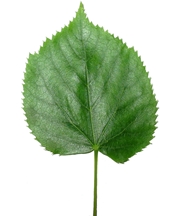ABSTRACTPlant morphology reflects evolutionary solutions to environmental constraints. In this experiment, students use this principle to predict the climate at their site. They collect and measure a set of traits on local tree leaf samples during the first meeting. At the following meeting(s), they pool their data and are introduced to a global database of climate and leaf morphology. In groups, they create regressions across sites and use their leaf data to predict mean annual temperature, which they compare to long-term observations from a local weather station. The experiment emphasizes quantitative analysis, data synthesis, and ecological responses to climate.
AUTHORSAaron B. Berdanier Duke University, Durham, NC 27708 USA; aaron.berdanier@gmail.com CLASS TIMEFour to six hours separated into two or three class meetings OUTSIDE OF CLASS TIMEOne to two hours for writing a group report STUDENT PRODUCTSStudents obtain local leaf data and predict local temperature based on regressions between leaf morphology and climate from a global database. Turned in as groups: data sheets from leaf observations and a report with results and discussion of findings. SETTINGThis experiment was initially conducted with trees found on an urban college campus (Beloit College, Beloit, WI). It requires sampling leaves of woody angiosperms from a diverse community to obtain sufficient species observations (recommended at least 15 different species). After collection, samples can be identified in a laboratory room or in the field. Data analysis is done in a computer lab. COURSE CONTEXTThis experiment was used in an introductory Botany class with two sections of 26 students each. The students were a mix of biology majors and non-majors from multiple grade levels. INSTITUTIONWhen teaching this experiment, I was a Visiting Instructor of Biology at Beloit College, a private liberal arts college with approximately 1,300 undergraduate students. TRANSFERABILITYThis experiment can be adapted to focus on different aspects (taxonomy, computation, physiology, ecology) and meet different educational needs. Since the experiment is based on global cross-site information, the concepts can be tested in a range of settings (urban or natural) across biomes, although the database only includes data for woody angiosperms, so access to tree samples is required. The exercise should be applicable for native or non-native species from local forest patches or open-grown plantings (e.g., around campus). It is also possible to conduct this experiment with local herbarium samples if collecting samples is undesirable. DOWNLOADSDescription of other Resource Files:
ACKNOWLEDGMENTSThis experiment was inspired by the Climate Leaf Analysis Multivariate Program, which has compiled global databases of leaf morphology and climate. I developed the experiment while I was a visiting instructor at Beloit College. Substantial feedback on the exercise was provided by Carol Mankiewicz, John Jungck, and Yaffa Grossman, as well as other members of the Ecological Research as Education Network. Comments from Kathy Winnett-Murray and anonymous reviewers at TIEE greatly improved the final submission. CITATIONAaron B. Berdanier. 30 July 2013, posting date. Leaves as ThermometersTeaching Issues and Experiments in Ecology, Vol. 9: Experiment #1 [online]. http://tiee.esa.org/vol/v9/experiments/berdanier/abstract.html |

Leaf morphological features vary across species and environments. (Source: http://commons.wikimedia.org/wiki/File:Lisc_lipy.jpg and licensed under the “GNU Free Documentation License) full size image |
<top> | |